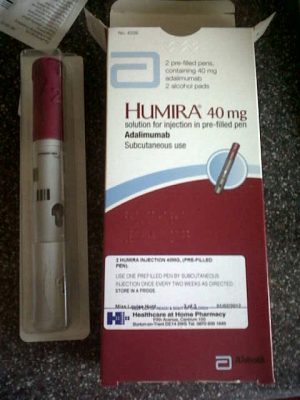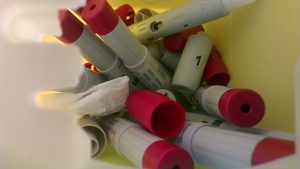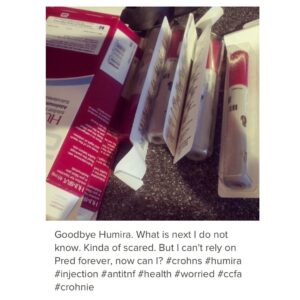
I received Humira for my Crohn’s Disease from December 2011 to January 2013.
It is also called Adalimumab, a biological medical treatment for Crohn’s Disease and several types of arthritis. It is what is called an Anti TNF inhibitor and follows on from Infliximab. It binds to TNF alpha preventing it from activating TNF receptors. In simple terms, it stops my bowels from reacting from inflammation; turning off my cells from fighting it.
It is licensed for use in adults and children with moderate to severe active Crohn’s Disease where other drugs such as immunosuppressants and steroids have not worked or are unsuitable. It is also a possible treatment for moderate to severe Ulcerative Colitis if conventional therapy hasn’t worked or isn’t suitable.[2]
Sounds rather amazing and complicated, and it is. But it comes with some risk: It lowers the patient’s immune system, leaving them subject to catching infections easier and fighting them becomes longer and harder than healthy people. It used for moderate to severe Crohn’s Disease sufferers. It can be used for up to a year, and after review, continued beyond 16 months.
I began my treatment of this drug back in December 2011. I had only been diagnosed with Crohn’s three months previously. I started as everyone else does: on Prednisolone and Pentasa, moving onto higher doses within a couple of weeks, being admitted and moved onto Azathioprine, and finally being admitted a week after starting Aza with a very bad reaction and horrible flare up. Humira was presented as an option before I started Azathioprine and I was granted funding for it soon after.

I started my initial loading doses in early December. I went through the pre-screening tests: Chest X Ray, blood work, medical history and removal of other medications (except Prednisolone and Adcal calcium). I used the pre-loaded subcutaneous pens that I injected into my thigh. I started with two pens – of 40 mgs each – in each thigh on one day. The following day, the IBD nurse got me to do the same under her supervision. Two weeks later, I was due for my third load – a single pen of just 40mgs. Two weeks after – my final hospital administered injection of 40mg – I was then released to do them at home on my own, with no supervision.
This approach of being ‘trained’ to administer your own medication is fundamental to the success of Humira and other self administered injections for IBD. If you come back to any of them after a year or more, you will need to be retrained.
I started doing one injection bi weekly at the start of January 2012. At first it was brilliant. I felt much better right away. I was bouncy and happy and had a great appetite. This continued until the start of March. Then things began to tailor off – I was back at work doing a full-time schedule and found it hard to keep up – and my attitude and behaviour changed. I was moody and annoyed quite easily, and found myself binge eating. Then in early April it felt as if my medication just wasn’t lasting the full fourteen days. I could go about 8 or 9 days without feeling sick or unwell but after that benchmark, I was feel drained and just very agitated, wishing away the days to my injection date. I used to be so good on those days. Then the fear of the needle started.

I got sick in early April – I caught a very bad cold from someone at work and it took ages to get rid of it. I got very stressed out, knowing my injection was coming up and I could not give it to myself whilst still sick. I wasn’t enjoying doing it like I used to, I knew that in reality it kept my Crohn’s at bay and avoided bigger flare ups – giving me an almost normal lifestyle – and I’m very grateful for that. But that needle, it gave me a sinking feeling in my stomach. I had to get my injections done by someone else for a while, until I was able to regain some confidence and get back in control again.
The intense pain I was experiencing within my joints meant that I came off Humira in January 2013. I was also experience little to no crohn’s symptoms, meaning my medication had worked to get me back to a good ‘base line’. With the support of my GI, I was going to try to go medication free for as long as I could. I was extremely hopefully in the beginning but it wasn’t to last. Throughout the rest of 2013 I battled numerous infections, abscesses, and increased IBD symptoms. In September, I was called in for my two endoscopy procedures to assess if was a candidate for Infliximab funding. After those 5 months, the scopes found more areas of diseased colon – noticeably more in the sigmoid, development of two stricture sites and cause for concern in the terminal ileum. Oh and a hiatus hernia at the bottom of my oesophagus. I was ordered back in for blood work to attach to my funding application my GI and IBD nurse were making the following week.

There has been recent talk in 2019 for me to return to Humira if I was to flare up again. Since my ostomy surgery and then subsequent proctectomy to make this a permanent fixture, I’ve come off Vedolizumab and been flare free for six months.
My experiences with Humira can be found here
